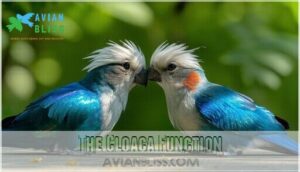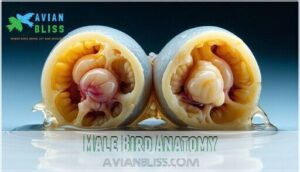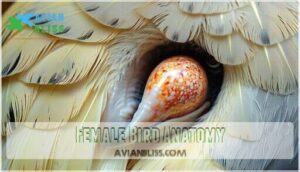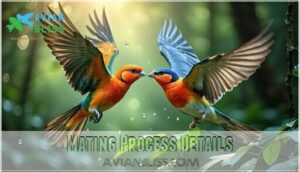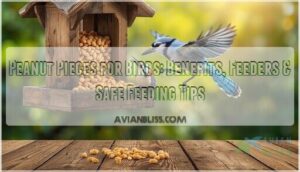This site is supported by our readers. We may earn a commission, at no cost to you, if you purchase through links.
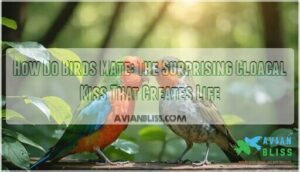 You might think how birds mate involves fancy equipment, but most male birds don’t have what mammals do.
You might think how birds mate involves fancy equipment, but most male birds don’t have what mammals do.
Instead, they perform what scientists call a "cloacal kiss" – basically a quick butt-bump where reproductive openings touch for just seconds.
It’s like nature’s version of a high-five, except it creates baby birds.
The male climbs on the female’s back, they line up their cloacas (that’s their all-purpose opening), and sperm transfers in a flash.
No romance novels here – just efficient biology.
But before this awkward dance happens, males pull out all the stops with colorful displays and sweet songs that’d make any dating app jealous.
Table Of Contents
- Key Takeaways
- Bird Mating Basics
- How Birds Mate Physically
- Bird Reproductive Anatomy
- Mating Process Details
- Attracting Mates Strategies
- Frequently Asked Questions (FAQs)
- How do birds mate physically?
- What do birds do when they are mating?
- Does mating feel good for birds?
- How do birds mate?
- How do birds begin their mating ritual?
- Are birds willing to mate?
- How do birds copulate?
- Do birds mate physically?
- How do you know when birds are mating?
- Do birds only have one hole for everything?
- Conclusion
Key Takeaways
- You’ll discover that most birds don’t have penises and instead mate through a "cloacal kiss" – a quick 1-5 second contact where both birds press their vents together to transfer sperm
- You’ll see that before the actual mating, male birds put on elaborate shows with colorful feather displays, complex songs, and courtship dances to attract females and prove they’re worthy mates
- You’ll find that birds have a unique all-in-one opening called a cloaca that handles reproduction, waste elimination, and egg-laying – it’s nature’s Swiss Army knife that swells during breeding season
- You’ll learn that after the brief cloacal kiss, females can store sperm for weeks, allowing them to mate with multiple partners and ensuring genetic diversity for stronger offspring
Bird Mating Basics
You might think birds mate like mammals, but they’ve got a totally different system that’ll blow your mind.
Birds ditched the mammal playbook and invented their own wild reproductive game that’s absolutely mind-blowing.
Most birds don’t have the equipment you’d expect – instead, they use something called a "cloacal kiss" that sounds way more romantic than it actually is.
Cloacal Kiss Process
Watching birds mate might seem awkward, but the cloacal kiss is surprisingly quick and efficient.
You’ll see the male hop onto the female’s back, both birds aligning their vents for just 1-5 seconds.
During this brief kiss duration, sperm transfers through perfect vent alignment.
The female’s post-kiss draw pulls sperm into her reproductive tract, completing this fascinating bird mating process.
Reproductive Anatomy
Understanding the cloacal kiss means knowing what’s happening underneath those feathers.
Bird reproductive anatomy is fascinatingly different from mammals, with unique adaptations that’ll surprise you.
Here are the key anatomical features that make avian reproduction work:
- Cloaca Evolution – Both sexes have this multipurpose opening that handles reproduction, digestion, and waste
- Seasonal Changes – Reproductive organs swell during breeding season, then shrink for efficient flight
- Waterfowl Penises – Ducks and swans are the rare exceptions with actual penetrative organs
- Avian Vents – The external opening where Internal Fertilization happens through brief contact
- Shared Chamber – One opening connects to testes, ovaries, intestines, and kidneys
This streamlined bird anatomy keeps things simple yet effective for creating new life.
Mating Displays
Male birds turn into flashy performers when it’s time to find love.
You’ll see incredible plumage displays as they show off bright feathers like peacocks fanning their tails.
Courtship dances involve synchronized moves that’d make TikTok stars jealous, and vocalizations range from sweet songs to weird honks.
Some even bring gifts – talk about romantic! These bird courtship rituals prove love makes everyone a little extra.
How Birds Mate Physically
Bird mating looks nothing like what you’d expect from nature documentaries.
Most birds don’t have the equipment mammals do, so they’ve gotten creative with their bird reproduction methods. Here’s how the magic happens:
- Cloacal Kiss – Both birds press their vents together for sperm transfer
- Waterbird Penetration – Ducks and swans actually have penises for underwater mating
- Vent Alignment – Perfect positioning guarantees successful bird insemination
The whole process takes just seconds, but sperm storage can last days before fertilization occurs.
Bird Reproductive Anatomy
You might think birds work like mammals down there, but they’ve got something way more interesting going on.
Instead of the usual setup, both male and female birds have this amazing all-in-one opening called a cloaca that handles everything from reproduction to waste elimination, which is a pretty unique aspect of their biology, making the reproduction process quite fascinating.
The Cloaca Function
You’re probably wondering what exactly this cloaca thing does.
Think of it as nature’s Swiss Army knife for birds.
The cloaca anatomy handles waste elimination, bird reproduction, and egg-laying all in one spot.
During seasonal changes, it swells for mating then shrinks back down.
It’s also where sperm storage happens in females.
Pretty efficient design, right?
Waterbird differences exist too.
Male Bird Anatomy
Now let’s peek inside the male bird’s reproductive toolkit.
You’ll find paired testes tucked safely inside his body, producing sperm and testosterone.
During breeding season, these organs swell dramatically – sometimes doubling in size!
Most male birds lack penises, storing sperm in their avian vent.
However, waterfowl break this rule with their impressive equipment for underwater bird copulation techniques, which is a notable exception in the bird kingdom, involving impressive equipment.
Female Bird Anatomy
Unlike their flashy male counterparts, female birds pack some serious reproductive hardware.
You’ll find they’ve got a single functional ovary (the left one) that’s connected to specialized shell glands for egg formation.
Their cloaca serves as the avian vent for reproduction, while hormonal control influences everything from plumage coloration to when those reproductive organs kick into high gear.
Mating Process Details
You’re about to discover exactly how birds pull off their famous cloacal kiss and turn it into new life.
Think of it as nature’s most awkward high-five that somehow creates baby birds in just a few seconds.
The Cloacal Kiss
When you witness the cloacal kiss, you’re seeing nature’s quickest romance.
The male balances on top while both birds press their avian vents together for just 1-5 seconds.
During this brief mating position, cloaca swelling helps align everything perfectly.
It’s like a high-speed handshake that transfers sperm – no penetration needed.
This kiss duration might be short, but it gets the job done efficiently.
Sperm Transfer and Fertilization
After the cloacal kiss, sperm travels through the female’s reproductive tract in seminal plasma, reaching fertilization sites within 48 hours.
You’ll find bird fertilization methods fascinating – females can store sperm for weeks, allowing multiple mating partners and sperm competition.
This genetic diversity strategy guarantees stronger offspring through polyspermic fertilization, where several sperm enter each egg, ensuring a process that involves genetic diversity.
Egg-Laying and Incubation
After fertilization happens, you’ll witness something amazing.
Female birds develop eggs inside their bodies over several days.
The bird egg laying process involves calcium-rich eggshell composition forming around the developing chick.
She’ll find the perfect spot in bird nests, then begins the bird incubation period.
Maintaining proper incubation temperature becomes essential for successful hatching process and future parental care responsibilities.
Attracting Mates Strategies
You’ve probably seen birds showing off with bright feathers, fancy dances, and songs that’d make a pop star jealous.
These aren’t just random performances – they’re carefully crafted strategies that help birds find their perfect match and guarantee their genes get passed to the next generation, which is a key part of their genes.
Visual Displays
Male birds transform into feathered peacocks during breeding season through display molting.
You’ll witness spectacular plumage coloration changes as drab browns become brilliant reds and blues.
Courtship dances feature synchronized movements and ritualized postures that’d make a Broadway choreographer jealous.
These bird plumage displays showcase fitness levels, with flashier feathers signaling healthier genes.
It’s nature’s ultimate fashion show with serious consequences.
Vocal Displays
Through song complexity and call variations, you’ll hear birds turning into feathered DJs during mating season.
Males belt out elaborate tunes while females judge their vocal talents like stern music critics.
Some species master mimicry learning, copying everything from car alarms to other birds.
To enhance these vocalizations, some enthusiasts use devices for amplifying birdsong.
Regional dialects even exist—think bird accents that vary by neighborhood, proving love truly speaks in many languages.
Olfactory Displays
You might think birds can’t smell much, but they’re actually using scent communication more than you’d expect.
Juncos sniff out potential mates through preen oil odors from their uropygial glands. These olfactory signals work like bird perfume, helping them identify strong "male-like" or "female-like" chemical cues.
Many bird enthusiasts utilize a specific bird attractant to enhance their environment.
Avian olfaction plays a bigger role in bird mating behavior than scientists once believed, with bird perfume being a key factor.
Gift-Giving and Mutual Feeding
Beyond scent signals, birds get romantic with their stomachs.
Courtship feeding turns dinner into foreplay—male shrikes impale mice on thorns like twisted valentines, while jays share berries just for kicks.
These nuptial gifts aren’t just sweet gestures; they’re strategic bonding rituals showing parental investment potential.
As seen in courtship feeding rituals, this behavior is quite common.
Food signals say "I’ll provide for our babies" louder than any song.
Frequently Asked Questions (FAQs)
How do birds mate physically?
97% of birds lack penises and mate through a "cloacal kiss" – briefly pressing their vents together for 1-5 seconds.
You’d see the male mount the female’s back while both align their cloacas to transfer sperm quickly.
What do birds do when they are mating?
When you watch birds mating, you’ll see the male mount the female from behind.
They press their cloacas together for just a few seconds in what’s called a "cloacal kiss" to transfer sperm.
Does mating feel good for birds?
You’d think they’d enjoy it, but science suggests otherwise.
Their brief cloacal kiss lasts just seconds and seems purely functional.
Unlike mammals, birds don’t appear to experience pleasure during mating—it’s all business, no fun.
How do birds mate?
Most feathered friends don’t have the equipment you’d expect.
They perform a "cloacal kiss" – pressing their vents together for a few seconds to transfer sperm.
It’s nature’s quickest handshake, lasting just moments before they fly apart.
How do birds begin their mating ritual?
Spring’s warmth triggers hormonal surges, longer days awaken instincts, and abundant food fuels energy.
You’ll notice males puffing chests, spreading colorful feathers, and belting out melodious songs to catch a female’s attention and start their romantic dance.
Are birds willing to mate?
Birds aren’t exactly "willing" like humans – they’re driven by powerful hormones and instincts. When breeding season hits, you’ll see them become absolutely obsessed with finding mates and reproducing.
How do birds copulate?
Like nature’s awkward dance, you’ll witness most birds performing a "cloacal kiss" – they briefly press their vents together for sperm transfer.
No penetration involved, just a quick touch lasting 1-5 seconds.
Simple yet effective!
Do birds mate physically?
Yes, you’ll find that most birds mate through a brief physical contact called a "cloacal kiss".
They press their vents together for just seconds, transferring sperm without penetration—it’s quick but effective.
How do you know when birds are mating?
Courting creatures create quite a commotion!
You’ll spot fluffed feathers, hear endless singing, and witness weird dances.
Males chase females relentlessly while showing off fancy plumage.
It’s basically nature’s version of an over-the-top rom-com performance.
Do birds only have one hole for everything?
Most feathered friends actually do have one opening called a cloaca that handles everything – reproduction, waste, and urination.
It’s like nature’s all-in-one system, though it swells during mating season to help things along.
Conclusion
Nature’s dating game might seem awkward, but birds have mastered romance in their own unique way.
Now you understand how birds mate through their surprisingly efficient cloacal kiss – no fancy equipment needed, just perfect timing and alignment.
From flashy feather displays to melodic serenades, these feathered Casanovas prove that love comes in many forms.
So next time you see birds courting in your backyard, you’ll appreciate the fascinating biology behind their brief but effective reproductive dance.

